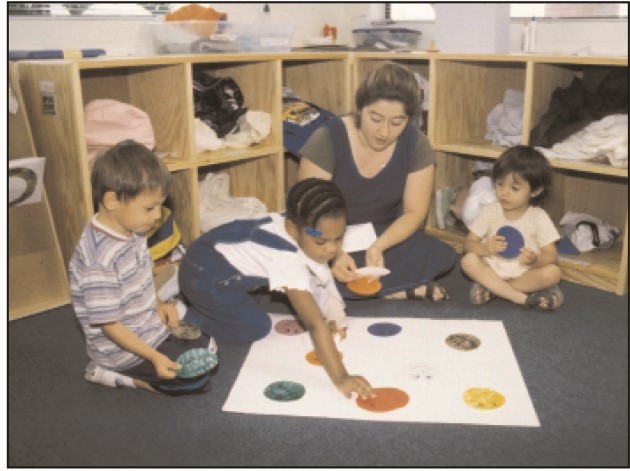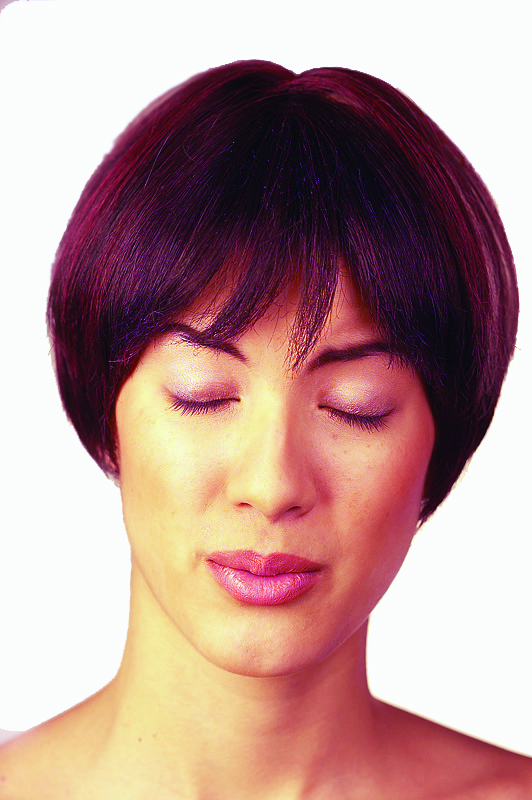3rd Year
MONTHS
25-26
3rd Year – Months 25-26
Thumb Sucking Is Very Common for Young Children

Thumb sucking is one way a young child comforts themself. If you suddenly stop your child from sucking their thumb or fingers, they may have trouble calming themself. Thumb sucking usually disappears on its own, especially if the child is not pressured to give it up.
Sometimes parents pull thumbs and fingers out of their young children’s mouths because they are worried about dental problems. There is little chance of a problem until the child’s permanent teeth erupt at 5 or 6 years of age. Even then, there may be no ill effects from thumb sucking every once in awhile.
If you are worried about your child’s thumb sucking, keep track of how often they suck and for how long. Take these notes for several days. This record will help you and your doctor or dentist discuss this and decide what to do.
What’s It like to Be 25–26 Months Old?

How I Understand
- I can match an object that is in my hand with a picture of the object.
- I can take turns when playing games.
- I know that there is a right way to do things. I am starting to compare my actions with the “right” way.
- I am starting to put easy puzzles (2 to 3 pieces) together.
How I Grow
- I need 3 small meals and 3 healthy snacks each day.
- I can use a crayon to make scribbles.
- I can use a cup and spoon. Forks may still be hard.
- I am starting to walk and run in straight lines.
- I can jump off the ground with both feet.
How I Feel
- I like routines —such as the story you read to me and the hug you give me every night at bedtime.
- I get upset when my routines are not followed.
- I feel good that I can do more things by myself.
- I am starting to treat children I know as my friends.
- I really like playing with other kids.
- I am better about being separated from you because now I know you’ll come back.
- I can get embarrassed.
How I Talk
- I say “no” a lot. This shows my independence.
- I like to hear rhymes, but it may be hard for me to say all the words with you.
- I talk more clearly now. Other adults can understand what I say.
- I am starting to use words for positions —like over, under, inside, and outside.
- I am also starting to refer to myself as “I” and others as “you” or “him.”
Some children do things earlier or later than described here. Most differences are normal. Focus on what your child can do and get excited about each new skill. If you notice that your child is lagging behind in one or more areas for several months, use this list to talk with your doctor about your child’s development.
Prevent Cuts and Scrapes
Small children get minor cuts and scrapes often. These happen when children fall, run into things, or step on sharp objects.
- Put shoes on your child when they play outdoors.
- Close doors to rooms that are not safe and doors that go outside.
- Do not let your child play where there is sharp-edged furniture.
- Do not let your child play where they can climb to high places.
Praise Effort, but Don’t Punish Toileting Accidents
Most children become interested in learning to use the toilet on their own. A potty on the floor that the child can use themself helps them to get started. Give them lots of praise for trying and for every success.
Don’t scold for accidents. Praise efforts to use the toilet. Most children will stop dirtying before they stop wetting their diapers. Most will be able to stay dry during the day before they can stay dry at night. Many children cannot stay dry at night until they are about 3 years old.
Sometimes children seem to be toilet trained and then they start wetting or soiling again. This can happen when the children are upset about some- thing like a new baby in the family, pressure from adults to stay dry or family stress.
Be patient and caring, and praise successes. Sure, you’re eager to be rid of diapers, but if you don’t rush toilet training, there will probably be less stress on everyone. Don’t start toilet training until your toddler shows they want to use the toilet. Then it should go quickly and smoothly.
Toilet training should not be upsetting to parents or their children. If it is, wait a few weeks and try again.
Teach Colors with Homemade Circles

You will need:
- Sheet of cardboard
- Five sheets of different colored paper
- Pencil
- Drinking glass
- Scissors
- Child safe glue. Check the bottle to be sure it says nontoxic or child safe.
To make the game:
- Make circles by drawing around a water glass on the colored paper. Make two circles of each color of paper. You will have 5 pairs of circles, each pair a different color.
- Cut out all of the circles; stack them in two separate piles.
- Glue one set of circles to the cardboard.
How to play:
- Place the cardboard in front of your child on the floor, or at a table.
- One by one, give them different colored circles. Ask them to put each one on the same colored circle glued to the cardboard.
- Say the name of the color as your child puts each circle on the correct color.
- When all the circles have been matched, have your child pick up the circles one by one and hand them back to you. Ask them the color of each circle as they hand it back to you.
Beware of High Sugar Cereals
 Has this happened to you yet? You are pushing your grocery cart down the aisle of the supermarket. All of a sudden, your toddler sees a certain brand of cereal. They begin calling out the name of the cereal. They want you to buy it. You are amazed. You’ve never bought this cereal, and they’ve never eaten it. How did they find out about it? They probably learned about it from television.
Has this happened to you yet? You are pushing your grocery cart down the aisle of the supermarket. All of a sudden, your toddler sees a certain brand of cereal. They begin calling out the name of the cereal. They want you to buy it. You are amazed. You’ve never bought this cereal, and they’ve never eaten it. How did they find out about it? They probably learned about it from television.
Toddlers don’t seem to pay much attention to television, but they are often aware of what is happening on the screen. Commercials are very appealing because of the action and the noise. The food most often advertised during children’s television programs is cereal. Some of these cereals are nutritious, others are not. In fact, some of these cereals have more sugar than cereal in them. They are more like candy than cereal.
How can you tell if a cereal is high in sugar? Look for the list of ingredients on the cereal box. They are listed in order of amounts. The first ingredient has the largest amount in the cereal. The last ingredient has the smallest amount in the cereal. If the first ingredient in the list is sugar, there is more sugar in the cereal than anything else. You will want to choose another cereal lower in sugar.
What do you tell your child when you decide not to buy the cereal? Say, “This is not a ‘good-for-you’ cereal. We want to buy a ‘good-for-you’ cereal to help you grow healthy and strong.” Check labels on other cereals and let them choose from the cereals that are low in sugar. If your child is unhappy because you aren’t going to buy the cereal they want, move away from the cereal display.
Go on and do the rest of your shopping. You can spend time reading cereal labels when you are shopping alone.
Teach Your Child New Words
Parents can help toddlers learn new words by:
- Repeating the names of things over and over again, using simple words and short sentences. Tell your child what you are doing and what your child is doing. Don’t use baby talk.
- Letting your child get things for you. Name what you want and ask your child to go to other rooms to find it.
- Going for walks and taking along a bag to collect leaves, rocks, flowers, and/or pieces of wood. When you get back home, look at these and name them.
You can play this learning game another way:
- Choose some things they might enjoy feeling, and put them in the bag. Examples would be a smooth rock, a rough rock, a piece of wood, a small stuffed animal, some pieces of cloth, a feather, and so on.
- Be sure the things you put in the bag are not sharp or dangerous.
- Close the top of the bag, leaving a hole just big enough for the child’s hand. Ask your toddler to reach in and find something.
- Ask your child to guess what they are touching – without looking or pulling it out of the bag. If they can’t figure it out let them peek.
- Ask them what they have found and help them learn to say, “I found a rock” or “I found a leaf.”
- You can take turns reaching in the bag and guessing what you’ve found.
- This is a good game for two or three to play together. Your toddler can help you change the game by putting different things in the bag.
Substitute Helpful Comments for Criticism and Put-Downs
 We all want our children to grow up feeling they are capable and lovable. One of the trickiest and most important skills parents must learn is guiding their children in ways that control naughty behavior and help their children learn to do what’s right. This is hard to do when you are angry or upset because your child is causing a problem. It takes a lot of practice and patience at these times not to be critical or accusing.
We all want our children to grow up feeling they are capable and lovable. One of the trickiest and most important skills parents must learn is guiding their children in ways that control naughty behavior and help their children learn to do what’s right. This is hard to do when you are angry or upset because your child is causing a problem. It takes a lot of practice and patience at these times not to be critical or accusing.
Children who hear “put downs” can come to feel hopeless, and may stop trying to cooperate. When your child misbehaves, they needs “help-outs” instead of “put-downs.” “Help-outs” make them feel you love them and you know they can learn to do better. “Putdowns” do just the opposite.
Here are some “help-outs”:
- Here’s a sponge. I’ll help you clean it up.
- That’s hard to do. Let me do it with you.
- I’m proud of you for trying that. Hold it with both hands next time and it may not fall.
- That is a dangerous thing to do. You could fall. Let me hold your hand.
Avoid “put-downs” like:
- I knew that would happen if I let you do it alone.
- Can’t you do anything right?
- You’re being a brat.
- Why do you always drop things?
- You never pick up your clothes.
- Won’t you ever learn?
- Can’t you see that’s dangerous?
Listen to yourself. Try to use “help-outs”—not “put-downs.”
A Hearing Test Is an Important Part of Your Child’s Regular Medical Checkup
- When a child is under 3 years of age, hearing is tested by observing your child’s response to sound and their ability to learn new words.
- When children turn three, they can usually learn how to take hearing screening tests.
- If your child has a hearing test, be patient. They may not understand what to do in order to cooperate fully.
Infants and toddlers frequently have colds that can lead to ear infections. If ear infections are not detected and treated, the toddler may have hearing problems.
- Catching hearing problems early is the key to successful treatment and the prevention of hearing loss. A hearing problem can interfere with the development of normal language and learning.
- Parents can protect their child’s hearing by making sure that infections are treated and hearing is regularly tested by their doctors.
Toddlers Need Patience, Humor, and Fair Rules
Twos are terrific, tender, trying, taxing, and very, very exciting. As a parent of a 2 year old, these are things you will need this year:
- Patience to cope with your child’s mood swings —from very helpful to highly difficult.
- Awareness to see that your child is safe.
- Loving firmness to apply rules in a consistent way so your child can learn to be responsible.
- Humor to laugh at yourself and with your child.
- Wonder to see your toddler as the creative, special person they are.
- Enthusiasm to enjoy and celebrate your toddler’s new skills and abilities.
Catch Health Problems Early with Regular Checkups

Toddlers grow fast. Regular health exams will help the doctor spot problems, and take care of problems early — while they still can be fixed.
If you do not have a doctor for your child, ask your local health department. They can give you the name of a doctor or health department clinic where your child can get a complete exam.
Keep your child’s health record in a safe place where you can find it easily. You will need the record when you enroll your child in day care, nursery school, or kindergarten. If your child needs special food or medication while away from home, the health record gives caregivers the correct medical information.
Toddlers should get health checkups at about 12 months, 15 months, 24 months, 36 months — and after age 3, every 2 years. Of course, if parents or doctors have special concerns about the child, exams will be more frequent.
Help Your Child Learn Their First and Last Name
- When you are with your child, say their name to them in songs and stories, using their last name, too.
- Make up games where they tell their name. Show them how much you enjoy it when they name themself in photos.
Hit a Pan with a Spoon to Teach Rhythm and Coordination
How to play:
- Show your child how to make different drumming sounds by hitting things with a spoon. They can hit a pan, a chair, the floor, their shoe, a bottle, and so forth.
- You can take turns leading the game, with each of you hitting one thing after another.
- Try drumming to singing or music, or you can mix fast and slow drumming sounds.

Match Activities to Development and Set Rules with Reasons

Parents of capable toddlers:
- Encourage their children to help with household chores.
- Have regular family routines (like mealtimes).
- Allow their children to do some messy things, such as washing dishes.
- Choose programs carefully, then limit and supervise their children’s television viewing.
- Observe their children closely to keep them safe —and to fit activities to their child’s developing skills.
- Read to their children daily.
- Have firm, consistent rules and give children reasons for these rules.
- Teach their children and actively help them learn.
- Play with their children frequently —including pretend play.
Exercises — Like Deep Breathing and Shoulder Rolls — Relieve Stress
Stress can make your body feel bad. Over the long term, stress can cause real damage. Over the short term, you may feel headaches, tight muscles, backaches, or a stiff neck.
Sometimes stress makes us breathe poorly, and we don’t get enough oxygen. Deep breathing can make you feel better, and it can give you a “time-out” to help you handle whatever is causing the stress.
- Close your eyes and sit up straight. Breathe in, slowly and deeply.
- Count silently to two — hold the air in for another count — then let the air out slowly.
- Repeat this slow, deep breathing for 5 to 10 minutes if you can. You will be more relaxed when you finish.
When your muscles are sore but you don’t have time to go swimming or walking, try these exercises wherever you are.
- Try to raise your shoulders up to your ears. Hold for a few seconds, and then drop your shoulders back down. Repeat a few times.
- Try rotating your shoulders around, one at a time, then together.
- With your shoulders relaxed, move your head slowly from side to side. Make sure to keep breathing deeply while you exercise.

Toddlers Need Fruits and Vegetables in Their Daily Diet
Active toddlers need 3 meals and 3 snacks every day. For more information on feeding your child healthy food, read the United States Department of Agriculture’s MyPlate website: https://www.myplate.gov/life-stages/toddlers
They should also be drinking plenty of liquids — like water or low-fat (1%) milk. Fresh fruit pieces, cut small enough not to be a choking hazard, should be served instead of fruit juice. Fruit juice, even though it is natural, has a high concentration of sugars and is lower in fiber than fresh fruit.
If you are still serving your toddler whole milk, now is the time to start switching to non-fat (skim) or low-fat (1%) milk. It offers the same nutrition benefits and vitamins without the extra fat that was needed last year.
Toddlers learn a lot by watching adults. They often imitate what they see, and want to do the things they see parents and other adults doing. This is true of eating. If parents eat healthy foods, children are more likely to eat healthy foods too. You can help teach your child good eating habits by eating healthy foods — like fruits and vegetables — with your child.
Bedtime Routines Help Toddlers Sleep Better
Toddlers need regular bedtimes and special bedtime routines —like teeth cleaning, stories, and hugs. Parents need regular bedtimes for their children, so that they can have some time to relax.
Bedtime is not always sleep time. By following a routine, you can help your toddler learn to go to bed and be quiet at set times. Don’t worry if they do not always go to sleep as soon as they go to bed. Sometimes toddlers need some time to wind down and relax before they get sleepy.
Try doing something relaxing before bedtime with your toddler —like reading a book or rocking. Rough-housing and watching TV before bed can make it hard for children to go to sleep. Try to do the same things every evening before putting your toddler to bed. If they still are not sleepy after the bedtime routine, let them play quietly in bed, or look at a picture book, until sleep comes.
Reminders
Subscribe: If you are not already a subscriber, you can receive the newsletters direct to your email on your child’s birthday. Register at JITP.info (English) or (Spanish).
Every child is unique: When reading this newsletter, remember: Your growing preschooler may do things earlier or later than described here.
Updates: We are constantly reviewing and updating JITP.info. See our current plans on the About Us page. Do you have questions or corrections? Email us at [email protected].
Credits: This newsletter was reviewed (2021) by Barb Beaulieu (Purdue University Extension), Dan Neigel and YaeBin Kim (University of Nevada-Reno), and Anne Clarkson (Wisconsin-Madison Extension). Dietary advice was provided by Dr. Jim Elicker & Dr. Kameron Moding.